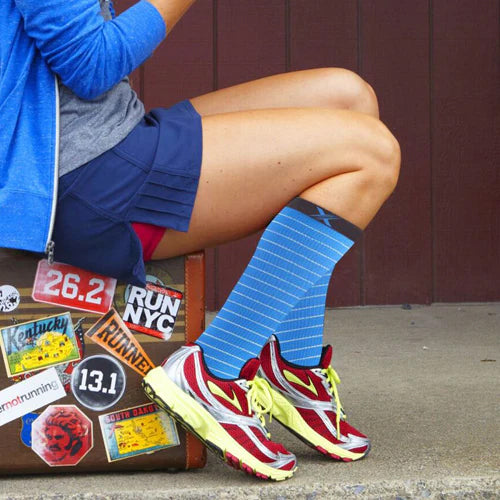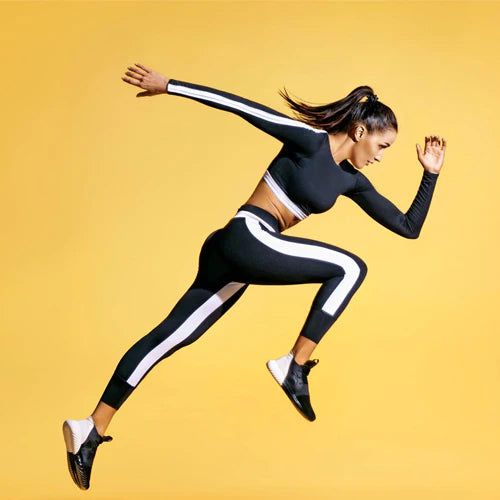If you’ve never needed them or thought of trying them, compression socks are kind of a mystery. Here are five things you should know about them.
Athletes Can Benefit From Compression socks:
Research shows that when athletes wear compression socks, they’re less sore after a performance. This is due to pressure socks’ ability to reduce strain on muscles during high-impact activities, and their assistance in providing circulation to the lower legs. They also reduce the number of lactates that are allowed to concentrate. This results in more comfort for you. Circulation socks can also be worn after a difficult workout to reduce soreness. They’re made out of materials that are designed to breathe, because the last thing you want is uncomfortable, heat-trapping fabric on your legs and feet while you’re working hard.
These socks give support and the knowledge that you’re doing something proactive to help yourself. Sports psychology has come a long way. People are recognizing their role in producing great results. Visualization is a good sports psychology tool. Imagine performing at your best. What does it feel like? What does it sound like? Imagine what you see around you as you push through barriers and achieve ideal form. Athletes and other types of performers had always had good luck charms, like lucky socks. A special pair of compression socks could be your secret good luck charm. Pick out a color that inspires you to do your best and makes you feel happy. Visualize yourself wearing them while you win a competition or break a personal record. When you wear them for the actual game, race, or competition, this will give you a psychological boost.
Compression socks for medical use:
Compression socks may be ordered by a doctor. This isn’t because they go well with a hospital gown (though they often do.) Reasons they are beneficial to include: surgical recovery, age, weight, and other health conditions. They help prevent DVT, or deep vein thrombosis, while patients are recovering from surgery. This way, drugs aren’t necessarily needed for blood clot prevention. The drugs can cause bleeding, so it’s ideal to avoid them.
Other actions such as leg exercises and walking will likely be recommended to help prevent DVT. You’ll need to do them regularly. You’ll be given instructions on how to do exercises correctly, and a physical therapist will help you with your form and technique. Get the most from your health care by doing them correctly. Having the best compression socks will help keep you motivated. Why not have your feet look cute as a morale booster? You will have doctors, nurses, and therapists in and out of your room all day. While looking good is by no means a requirement (as evidenced by hospital gown design) it makes you feel a little better. Compression socks also help keep your feet from getting cold. Hospitals can be chilly, with their tile floors and controlled air quality.
You won’t be the only one in the hospital wearing comfortable compression socks. Nurses find them beneficial in preventing the pain that accompanies long hours on their feet. The best compression socks inhibit swelling and reduce both spider and varicose veins. Comfortable compression socks make a tough job easier.
If they make you healthy and keep caregivers comfortable, what’s not to love?
When to Wear Compression Socks:
Wearing them correctly is important. You want to do this, because fit is key. If you have numbness or tingling, remove them. You can wear rubber gloves to help with gripping them as you pull them on. Keep them in their original state; don’t cut them or fold them. Wash them as directed, because improper care could cause them to fit poorly. Put them on early in the day. You can work up to wearing them for longer amounts of time. Changes in your weight will affect fit, so pay attention to that. You’ll get a feel for what excellent fit is like and notice any deviation. You’ll probably enjoy the feel of them and crave the firm support they provide. There have never been so many options for colors and styles, which makes wearing them more fun than in the past.
Compression Socks for Travel:
Comfortable compression socks are good to wear when travelling. Doctors approve of wearing them on long flights. They also recommend stretching and moving around to keep legs comfortable. If you regularly wear compression socks, you’ll want to wear them while sightseeing. Your legs will benefit from them just as they do during daily life. If you’ve never worn them and want to wear them for a long flight, buy some flight socks well ahead of your trip and get used to them beforehand.
Make sure your footwear is good for travel. Take some long walks over uneven ground to see if your socks, shoes, and sock/shoe combinations are comfortable. Buy as many pairs of compression socks as you need. While some people are able to pack light by doing laundry during their trip, these socks have specific washing and drying instructions. Nobody wants to have to bring a drying rack on vacation, so bring a pair for each day.
Who Invented Compression Socks?
They were invented by engineer Conrad Jobst, who had venous ulcers in his legs. He discovered that when he was in a pool, his legs felt better due to the pressure from the water. He worked with a physiologist, Dr Otto Gauer, to create these circulation socks. They distribute pressure differently on various areas of the leg so as to get the desired result. They’re more than just a tall sock.
Stylish Compression Socks
They look good with your stylish footwear. No longer a stodgy secret, they’re available in colors and prints. And why shouldn’t they be? Fun patterns can be worn under business attire to give you a cheerful secret. They add a bulk-free layer of fabric to your legs, which is great for cool weather.
Now you know why and how to wear compression socks. Shop for men's compression socks or compression socks for women. Designed for your comfort and health, they are good for your legs and feet.





